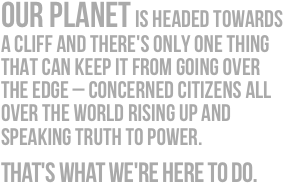by Graham Reeder
So after two weeks of singing and dancing in designated, coordinated, preapproved, action spaces, the official youth constituency just made their first risky move at this COP. Anjali delivered a powerful high-level plenary intervention about how the youth are being failed and how developed countries are to blame for delay on ambitious climate action, and the youth followed it up by a powerful human microphone with the lines “Mic check! Equity Now! You’ve run out of excuses. We’re running out of time. Get it done! Get it done! Get it done!” The Human Microphone (or the people’s microphone) has been a tactic used since before the World Trade Organization protest in 1999 but has recently made a comeback with the Occupy Movement.
What was truly incredible about this action was that it received consensus approval by the official youth constituency morning meeting. Although it wasn’t clear whether or not this is an ‘unsanctioned action’, there is no doubt that it was a risk. The official youth constituency can’t approve unsanctioned action, and is usually very hesitant to push any aggressive messaging. Earth in Brackets is ecstatic to see the youth come together on the things that unite them and take a strong stance. I wonder though, why only now? Why is it that we have to wait until the last day of COP to get a sense of a movement being present in the halls of the ICC? My sense is that there were a lot of fears of people losing their badges and their chances of getting future accreditation. Although I understand this to a certain extent, I’m not sure I understand why it is that people are using such an intense amount of resources to get here and choosing not to speak up. Anjali made a good point in her intervention, ambition and action are not radical, what is radical is changing the climate of the earth, sitting back and letting it happen is radical too. I’m concerned that I see a huge portion of the youth here itching for more risks but the sense of status quo remains dominant. I strongly commend the actions of the 6 Canadian youth who took a stand (literally) and interrupted the Canadian delegation’s speech to point out who they work for and the Abigail’s action for the American youth by obstructing Todd Stern’s public voice at the convention. Both of these actions have garnered attention from major western press outlets, I haven’t seen any sing-a-longs on the New York Times website recently. Their actions and others like them are what this movement takes, not a pep rally.
This doesn’t just go for the youth though, I’ve watched the largest environmental NGOs that have come to represent the environmental movement in the media continually cut dangerous deals and make compromises on issues that aren’t theirs to compromise on. I’m really concerned that a handful of European and North American non-grassroots NGOs are the ones who decide if Durban is a success or not for the media; it’s not up to them. There are plenty of grassroots organizations that represent a much broader constituency (and a much more vulnerable one) that have the opinions but not the voice, they end up leaving the room rather than taking it over.
My major questions are these: What does it take to develop a sense of ambition? How is it that activists and policy wonks like me can get the message across to civil society that their governments will have no interest in doing anything until something gets shoved down their throat by the people who elect them? In turn, what are the strategies that grassroots civil society groups can use to bring our governments’ attention span away in a real way from powerful dirty corporate lobbyists to a science and human rights based approach to climate change? How do we do the same with the top-down NGOs?
I’m not being naïve here, I understand that the fossil fuels industry is the most profitable industry in history and that, in turn, they have the most powerful lobby the western world has ever seen. I’m not particularly interested in either naïve idealism or lazy defeatism; I’m asking for concrete strategic thoughts and suggestions.


